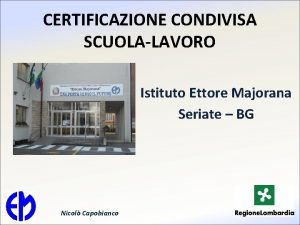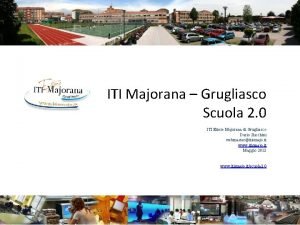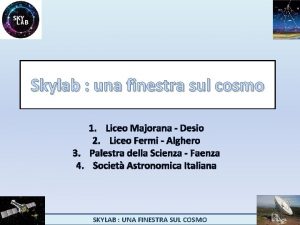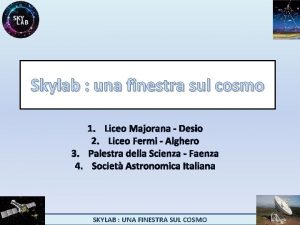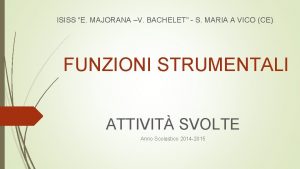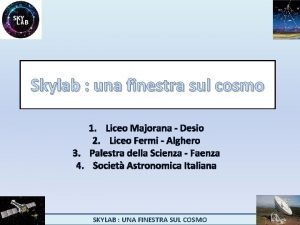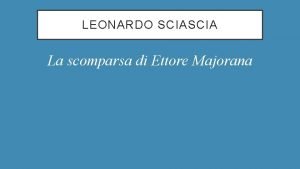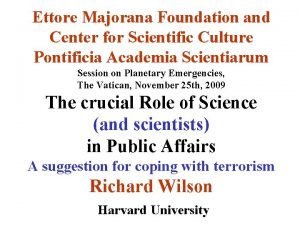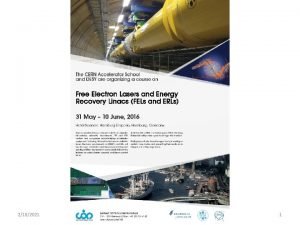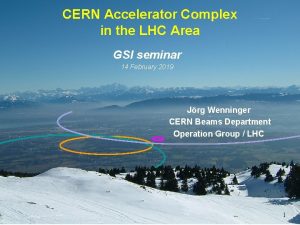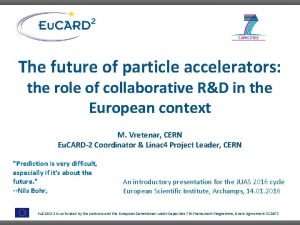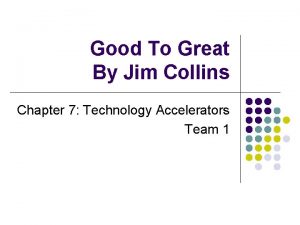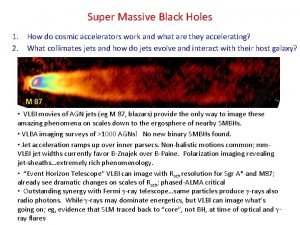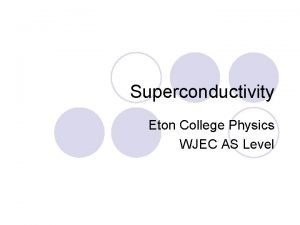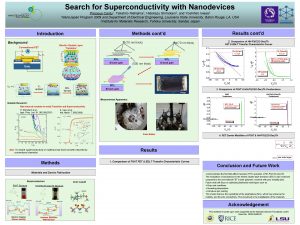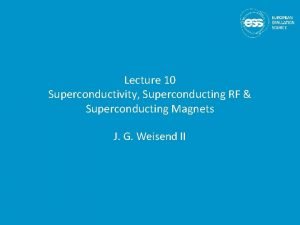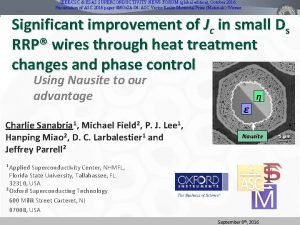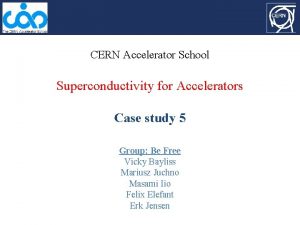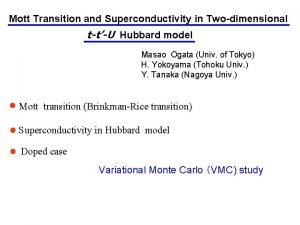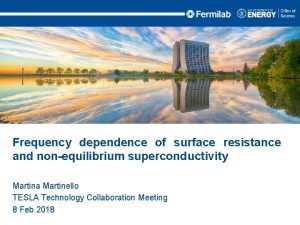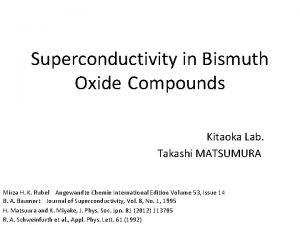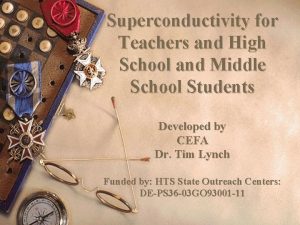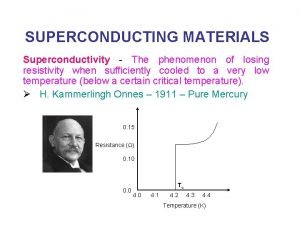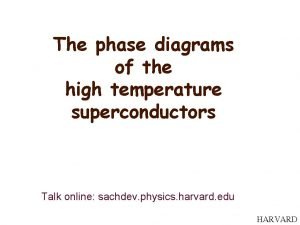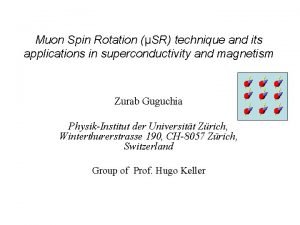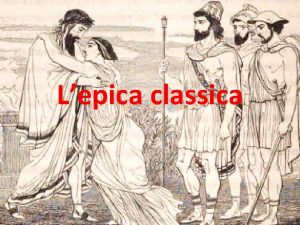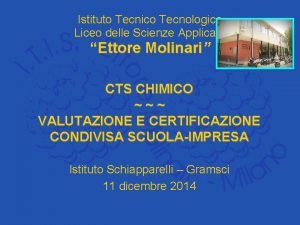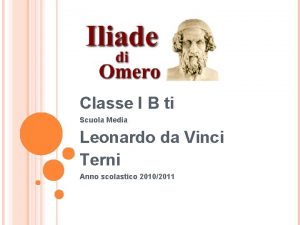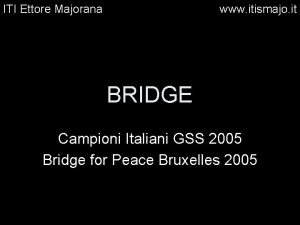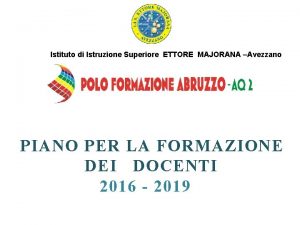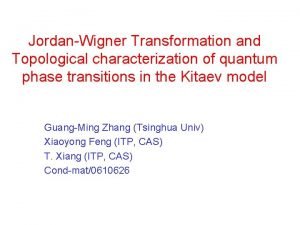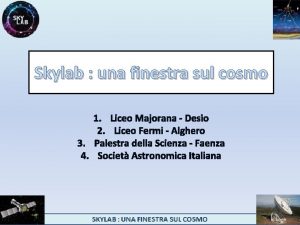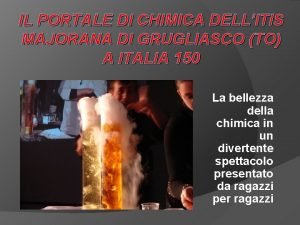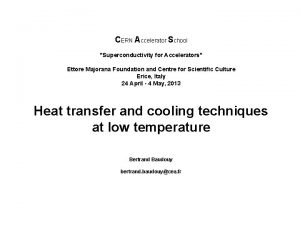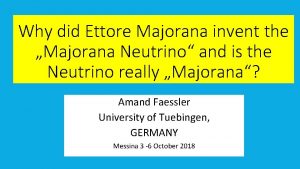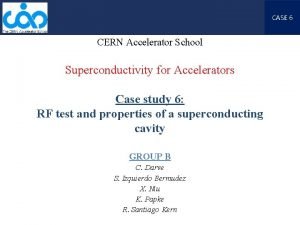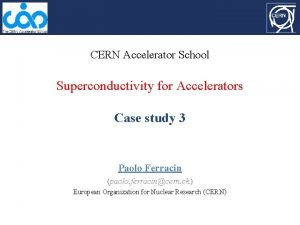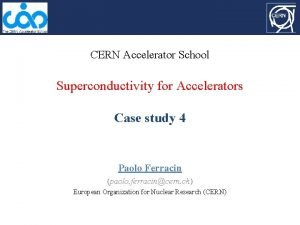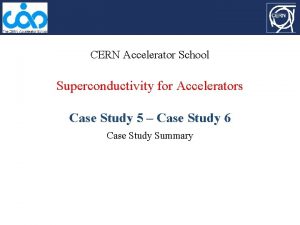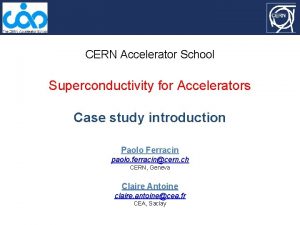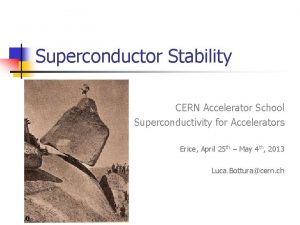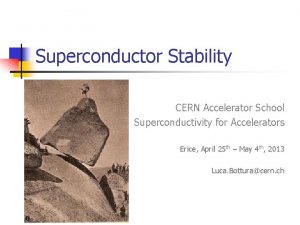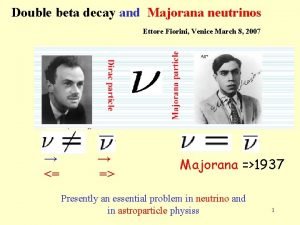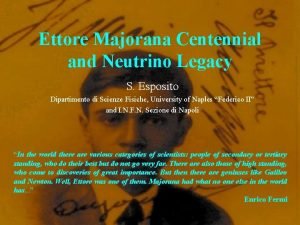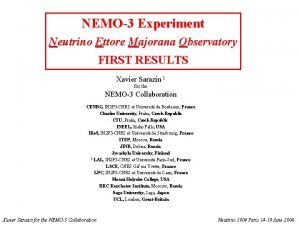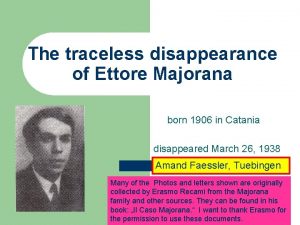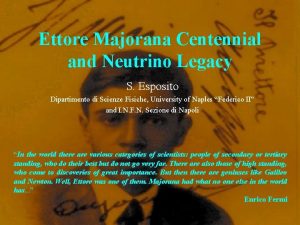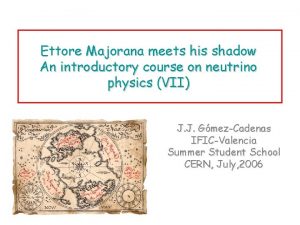CERN Accelerator School Superconductivity for Accelerators Ettore Majorana









































- Slides: 41

CERN Accelerator School "Superconductivity for Accelerators" Ettore Majorana Foundation and Centre for Scientific Culture Erice, Italy 24 April - 4 May, 201 Heat transfer and cooling techniques at low temperature Bertrand Baudouy bertrand. baudouy@cea. fr

Outline • Heat transfer at low temperature (Lecture 1) – Conduction – Radiation – Convection • Cooling techniques at low temperature (Lecture 2) – Different classifications of system with respect to cooling – Different methods of cooling – Some examples BB, CERN Accelerator School – Erice – April 25 th May 4 th 2013 2

Cooling methods at low temperature (Lecture 2) • Content – – Introduction Different classifications of system with respect to cooling Review of the different cooling methods Examples of system • Just a few words in this lecture – Superfluid helium cooling methods • Not included in this lecture – Cooling below 2 K • Present until the end of the school, do not hesitate to ask BB, CERN Accelerator School – Erice – April 25 th May 4 th 2013 3

Cooling to the low temperature (1/3) • Primary goal : maintain a system at temperature T≪ room temperature – Thermal stability in steady-state regime → Tsystem ≈constant – Protection of your system against transient events →Tsystem<Tmax 300 K • System defined by thermophysical properties, geometry, orientation, environment, confinement… • System subjected to permanent heat input (heat losses), Qp Qp – Thermal radiation (room temperature to Tsystem) – Conduction through supports, current leads, … – Internal dissipation (Joule effect, AC losses, beam losses…) • System subjected to transient heat perturbation, Qt – Quench of a superconducting cavity or magnet BB, CERN Accelerator School – Erice – April 25 th May 4 th 2013 Qt Tsystem 4

Cooling to the low temperature (2/3) • Cooling power provided to the system, QR – Direct contact with cryogen (wet system, cavities, …) • Thermophysical properties of the cryogen • Contact heat transfer coefficient, h [W/m 2] 300 K Qp – Indirect contact with cryogen • Thermal link (liquid or gas, flow or no flow) • Heat exchanger (series of tubes, …. ) – Without cryogen (Dry magnet, cryogen-free system) • Performance and the temperature range of the cryocooler • Heat distribution system, thermal links h Qt h Tsystem Tb • System design at low temperature – Minimize the heat input • Minimization of the heat transfer at a constant temperature difference – Maximize the heat extraction (cooling QR) • Minimization of the temperature difference for a constant heat transfer BB, CERN Accelerator School – Erice – April 25 th May 4 th 2013 5

Cooling to the low temperature (3/3) • Common cryogenic fluids and “usable” superconductors Fluid He 4 H 2 Ne N 2 O 2 Boiling temperature @ 1 atm (K) 4, 2 20, 4 27, 1 77, 3 90, 2 Latent heat of vaporization (k. J/kg) 21 452 86 199 213 1550 3800 280 233 193 0, 7 9, 0 29, 0 45 68 Sensible heat from 300 K and Tboiling (k. J/kg) Power to evaporate 1 liter Approximate price €/liter BB, CERN Accelerator School – Erice – April 25 th May 4 th 2013 7 0, 15 6

Outline | Different classifications of system • Cooling methods at low temperature (Lecture 2) – Different classifications of system with respect to cooling • Dry systems • Indirect cooling • Wet systems – Different methods of cooling • • • Baths Forced flow Two-phase flow Cryogen free cooling Coupled systems – Some examples • • • Large detector magnets Superconducting RF cavities Accelerator magnets Fusion magnets Life science magnets BB, CERN Accelerator School – Erice – April 25 th May 4 th 2013 7

Cooling classification | Dry Systems • Cryogen-free (no cryogen) – Conduction only in the system • Cold source – Cryocooler • Reasons – Non cryogenic environment preferred – Small heat load – Slow perturbations process • Examples – Room temperature bore magnets – Small MRI magnets –… BB, CERN Accelerator School – Erice – April 25 th May 4 th 2013 18 T cryogen free magnet with HTc K. Watanabe, J Supercond Nov Magn (2011) 24: 993– 997 8

Cooling classification | Indirect cooling • No direct contact between the cryogen and the system – Conduction in the system: important parameter – Surface heat transfer: less important • Cold source – Liquid bath – External flow of cryogen • Reasons – – Moderate heat load – no need to have an “overall” large heat transfer rate No “vaporization” zone in confined geometry Reduction of the cryogen quantity Slow perturbations process • Examples – Large detector magnet like CMS or Atlas at CERN Coil cross section of the CMS magnet Two-phase helium flow external cooling ©CERN BB, CERN Accelerator School – Erice – April 25 th May 4 th 2013 9

Cooling classification | Wet Systems • Direct contact between the cryogen and the conductor – Heat transfer in the system (coil for magnet) – Enthalpy reserve in the liquid (in the system) • Cold source – Liquid bath – Stagnant coolant (He II pressurized or saturated) – Single phase flow (supercritical) • Reasons Iseult – 11. 7 T whole body MRI (CEA Saclay) Coil model – Need of a large overall heat transfer rate due to large heat loads (steady-state or transient) – Need of surface temperature uniformity • Examples – – Accelerator magnets (LHC magnets) CICC magnets (ITER, 45 T NHMFL magnet) He II cooled magnet (Tore Supra, Iseult) Superconducting cavities ITER Cable-In-Conduit conductor BB, CERN Accelerator School – Erice – April 25 th May 4 th 2013 10

Outline | Different methods of cooling • Cooling methods at low temperature (Lecture 2) – Different classifications of system with respect to cooling • Dry systems • Indirect cooling • Wet systems – Different methods of cooling • • • Baths Forced flow Circulation loop Cryogen free cooling Coupled systems – Some examples • • • Large detector magnets Superconducting RF cavities Accelerator magnets Fusion magnets Life science magnets BB, CERN Accelerator School – Erice – April 25 th May 4 th 2013 11

Cooling methods Direct cooling Bath cooling Direct cooling Forced flow Indirect cooling Bath cooling Indirect cooling Bath as cold source Indirect cooling Forced flow Indirect cooling Two-phase thermosiphon BB, CERN Accelerator School – Erice – April 25 th May 4 th 2013 Indirect cooling Cryocooler as cold source Thermal link Indirect cooling Two-phase thermosiphon Coupled with a cryocooler 12

Cooling methods | Baths (1/2) Phase diagram of helium • Saturated bath (P=1 Atm and T≈Tsat) ΔTsub – – Latent heat cooling (phase change) Sensible heat (if subcooled) No cryogen flow Direct and indirect cooling – Advantages • • Simple design and operation for cryogenics Almost constant surface temperature (ΔT small) High heat transfer (nucleate boiling) If sub-cooling then extra ΔTsub before boiling (natural convection) – Disadvantages • • • Discrete temperature cooling (He 4. 2 K, H 2 20. 4 K, N 2 77. 3 K…) Large quantity of cryogen to handle in case of quench (pressure rise) Non uniform cooling if vapor formation If q>qcr then film boiling (an order of magnitude smaller heat transfer) h dependent on orientation and gravity BB, CERN Accelerator School – Erice – April 25 th May 4 th 2013 13

Cooling methods | Baths (2/2) Phase diagram of helium • Superfluid helium bath – Heat transfer in He II (conduction-like in liquid) – Surface heat transfer (Kapitza resistance) – Direct and indirect cooling – Advantages • Huge heat transfer rate: k≈105 W/m. K • h independent of orientation and gravity ΔTsub – Disadvantages • Thermal (Kapitza) resistance between solid and He II – Rk=3 10 -4 K. m 2/W for Cu and Rk= 10 -3 K. m 2/W for Kapton • Large quantity of cryogen to handle in case of quench – Saturated bath (superconducting cavity) • If sub-cooling then extra ΔTsub before boiling • Large volume below atmospheric pressure (leaks) – Pressurized bath (for LHC magnets) • Finite ΔT (0. 3 K) before reaching He I • Costly and complicated design and operation – Heat exchanger needed BB, CERN Accelerator School – Erice – April 25 th May 4 th 2013 Huge Heat transfer : no boiling in he II 14

Cooling methods | Forced flow (1/4) • Single phase forced flow – Sensible heat, advection – Indirect and direct cooling – Advantages • Smaller amount of cryogen if external circuits • Save space and weight in the system design • High heat transfer rate adjustable with mass flow rate Tatsumoto H, et al. Forced Convection Heat Transfer of Liquid Hydrogen Through a 200 -mm Long Heated Tube. Physics Procedia. 2012; 36(0): 1360 -5. – Disadvantages • Pressurization system or circulation pumps to implement and maintain at low temperature • Heat exchanger to sub-cool the fluid • Range limitation due to finite sub-cooling – Sign of the JT coefficient important • If JT coefficient negative then in a flow ∆P ↘ implies ∆T ↗ (Tfluid ↗) • If JT coefficient positive then (Tfluid ↘) BB, CERN Accelerator School – Erice – April 25 th May 4 th 2013 15

Cooling methods | Forced flow (2/4) • Two-phase saturated forced flow Ogata, Forced convection heat transfer to boiling helium in a tube, Cryogenics July 1974, p. 375 – Latent heat – Sensible heat, advection – Indirect cooling – Advantages • • • Almost isothermal flow High heat transfer rate up to high vapor quality Save space and weight in the system design Smaller amount of cryogen because of external circuits Helium : qmax≈3. 103 Wm‑ 2 Ø 10 mm m=610‑ 3 kgs‑ 1 and ΔT≈1 K; no sub-cooling Mahé, Ph. D CEA Saclay 1991 – Disadvantages • • Discrete temperature cooling (He 4. 2 K, N 2 77. 3 K et H 2 20. 4 K, …) Non uniform cooling if vapor formation If q>qcr then film boiling (an order of magnitude smaller heat transfer) h dependent on orientation and gravity BB, CERN Accelerator School – Erice – April 25 th May 4 th 2013 16

Cooling methods | Forced flow (3/4) • Supercritical forced flow (helium) Giarratano, Forced convection heat transfer to supercritical Helium, Cryogenics, Oct. 1971 p. 385 – Sensible heat, advection – Direct and indirect cooling – Advantages • Single phase flow (no vapor formation) • Comparable heat transfer coefficient to pool boiling – Classical heat transfer q≈104 W/m 2 for ΔT≈1 K – JT coefficient positive or negative • Adjustable heat transfer with mass flow (temperature optimization) • Cooling system can be « plugged » to refrigeration plant and be used for cooling from 300 K – Disadvantages • Pressurization system – Absolute pressure P≈3 -8 bar + extra ∆P in the system • Periodic re-cooling for operation (series of large magnets) BB, CERN Accelerator School – Erice – April 25 th May 4 th 2013 17

Cooling methods | Forced flow (4/4) • Superfluid helium forced flow (helium) – He II heat transfer and advection • Advantages – Same advantages as static He II – Large heat transfer – Classical frictional Δp up to Re≈107 • Disadvantages S. Fuzier, et al. , Cryogenics, Volume 41, Issues 5– 6, Pages 453 -458 – Negative JT coefficient close to saturation – Needs specific pumps, heat exchanger, more complicated cooling scheme – Transition velocity for advection effect (1 m/s @ 1. 8 K) • JT effect – Smooth tube : Dh=10 mm, Δp=0. 3 bar ⟶ΔT=0. 1 K • Never applied in accelerator magnets BB, CERN Accelerator School – Erice – April 25 th May 4 th 2013 18

Cooling methods | Natural circulation loop • Natural circulation loop – « Open loop » • Vapor goes out of the system • Reservoir must be filed to avoir dry-out – « Closed loop » • Vapor is re-condensed in the reservoir – Flow is created by the weight unbalance between the two branches due to vaporization or decreased density – Mass flow rate linked to the heat flux – No pumps or pressurization system – Auto-tuned mass flow rate Q Case of a two-phase circulation loop BB, CERN Accelerator School – Erice – April 25 th May 4 th 2013 19

Cooling methods | Natural circulation loop • Single phase natural convection – Buoyancy – Direct and indirect cooling – Advantages • No pressurization system • High heat transfer rate • In a circulation loop – Nitrogen flow qx≈4103 Wm‑ 2 for Ø 10 mm – m=40 gs‑ 1 and ΔT≈3 K – Disadvantages • Must have gravity! • In a circulation loop, mixed convection – Forced convection reduces natural convection Mixed convection correlation Nitrogen Baudouy B. Experimental study of a nitrogen natural circulation loop at low heat flux. Adv. in Cryo. Eng. 55 A, AIP Conf. Proc. 1218; 2010. p. 1546 -53 BB, CERN Accelerator School – Erice – April 25 th May 4 th 2013 20

Cooling methods | Two-phase circulation loop (1/2) • Open vertical two-phase circulation loop – Latent heat, sensible heat, advection – Indirect cooling – Advantages • • • No pressurization system (no pump and its associated maintenance) Auto-tuned mass flow rate Reservoir above the liquid serves as a reservoir in case of cryogenic failure Reduced cryogen quantity Baudouy B. Experimental study of a nitrogen High heat transfer rate natural circulation loop at low heat flux. In: Adv. in – Nitrogen flow qx≈104 Wm‑ 2 for Ø 10 mm m=40 gs‑ 1 and ΔT≈2. 5 K Cryo. Eng. 55 A, AIP Conf. Proc. 1218; 2010. p. 1546 -53. – Helium flow qmax≈103 Wm‑ 2 for Ø 10 mm m=20 gs‑ 1 and ΔT≈0. 3 K Benkheira L, et al. Heat transfer characteristics of two-phase He I (4. 2 K) thermosiphon flow. IJHMT, 2007; 50(17 -18): 3534 -44 – Disadvantages • • Must have gravity! Reservoir high enough above the circuit to create a sufficient ∆P (driving force) Requires permanent refill to avoid dry-out in the cooling branches One order of magnitude lower critical heat flux compared to pool boiling BB, CERN Accelerator School – Erice – April 25 th May 4 th 2013 21

Cooling methods | Two-phase circulation loop (2/2) – Circulation loop with horizontal parts possible (but not at the bottom) • Instability at low heat flux • But high heat transfer • Open horizontal two-phase circulation loop B. Baudouy et al. Modeling of a horizontal circulation open loop in two-phase helium, Cryogenics, Volume 53, January 2013, Pages 2 -6 Gastineau B, et al. R 3 B-GLAD magnet R&D tests program: Thermosiphon loop with horizontal section, superconducting cable joints at 3600 A, and reduced scale “coil in its casing” mock-up. IEEE Transactions on Applied Superconductivity. 2012; 22(3): 900 -1004. Evolution of the total mass flow rate (a) and wall ∆T (b) at the bottom and top of Ø 10 mm tube at 3. 508 m from the entrance of the tube for 5 W/m 2 BB, CERN Accelerator School – Erice – April 25 th May 4 th 2013 22

Cooling methods | Large open thermosiphon • Open thermosiphon with a closed tube – Counter-current two-phase flow – Indirect cooling – Advantages • Even simpler design and less cryogen • Large heat transfer rate – Disadvantages • Low critical heat flux • Flooding, instability – Helium case • 1 m long, Ø 10 mm • h~104 W/m 2. K • qc ~100 W/m 2 BB, CERN Accelerator School – Erice – April 25 th May 4 th 2013 Baudouy B. Experimental study of heat transfer in a vertical uniformly heated closed-end tube submerged in saturated liquid helium. In: Proceedings of the 21 th ICEC 2006. p. 381 -4. 23

Cooling methods | Conduction (1/2) • Cryogen-free cooling – Conduction between the cold source and the system – Indirect cooling – Advantages • Easy implementation (no liquid, no heat exchanger, no transfer line, …) • Suitable for small power system without large transient event – Disadvantages • Finite cooling power - thermal design must be accurate if real power to be extracted exceeds the cryocooler power, then what? • A point-source of cold (distribution of cooling power) • Conductive diffusion limit for transient – Examples • 10 T magnet class commercialized since 1990 • 18 T Nb. Ti and Nb 3 Sn magnet (MIMS, Toshiba et TIT) BB, CERN Accelerator School – Erice – April 25 th May 4 th 2013 A. Sato, Mi. MS 24

Cooling methods | Conduction (2/2) • GM Cryocooler characteristics – 4 K two-stage cryocooler • 2 nd stage 1. 5 W at 4. 2 K • 1 st stage 30 W at 50 K – 20 K two-stage cryocooler • 2 nd stage 10 W at 20 K • 1 st stage 35 W at 77 K 4 K class cryocooler – 77 K single stage cryocooler; several 100 W! • Cryocoolers are point-source of cold systems and a power distribution is needed (thermal links) • Conductive links • Small loops with Twophase fluid 10 K and 77 K class cryocoolers BB, CERN Accelerator School – Erice – April 25 th May 4 th 2013 25

Cooling methods | Capillary pumped device (1/2) • Flow is created by capillary pressure in porous media at the liquid/vapor interface (Evaporator) • Wick-based heat pipe (System to be cooled) Heating – Large ∆T between condenser and evaporator Nitrogen heat pipe Heat pipe length 85. 5 cm Pipe diameter 4 cm Wick material stainless steel mesh Vapor Liquid Cooling (cryocooler) (condenser) BB, CERN Accelerator School – Erice – April 25 th May 4 th 2013 D. W. Kwon et al. Cryogenic heat pipe for cooling high temperature superconductors, Cryogenics, Volume 49, Issue 9, September 2009, Pages 514 -523 26

Cooling methods | Capillary pumped device (2/2) • Cryogenic loop heat pipe – Heat pipe in a loop configuration (mass flow) • Heat transfer in Nitrogen – ∆T=6 K for 40 W for 0. 5 m long – Rth ↘ for the heat load Y. Zhao, et al. Experimental study on a cryogenic loop heat pipe with high heat capacity, Int J Heat Mass Transfer, 54 (2011), pp. 3304– 3308 BB, CERN Accelerator School – Erice – April 25 th May 4 th 2013 27

Cooling methods | Oscillating Heat Pipe • Pressure change due to volume expansion and contraction at phase transition • Oscillation of liquid slugs and vapor bubbles between the evaporator and the condenser • Advantages – Easy to implement – Large heat transfer K. Natsume, Heat transfer performance of cryogenic oscillating heat pipes for effective cooling of superconducting magnets, Cryogenics, Volume 51, Issue 6, June 2011, Pages 309 -314 Fluid Heat input (W) Cooling part temperature (K) Heating part temperature (K) Keff (k. W/m. K) H 2 0 -1. 2 17 -18 19 -27 0. 5 -3. 5 Ne 0 -1. 5 26 -27 28 -34 1 -8 N 2 0 -7 67 -69 67 -91 5 -18 BB, CERN Accelerator School – Erice – April 25 th May 4 th 2013 28

Cooling methods | Thermosiphon • Counter-current two-phase flow • Same advantages as the open large thermosiphon • Autonomous loop • Heat transfer in nitrogen – Rth=0. 5 K/W for 20 W and ∆T=10 K A. Nakano, et al. An experimental study of heat transfer characteristics of a two-phase nitrogen thermosyphon over a large dynamic range operation, Cryogenics, Volume 38, Issue 12, December 1998, Pages 1259 -1266 BB, CERN Accelerator School – Erice – April 25 th May 4 th 2013 29

Cooling methods | Natural circulation close loop • Co-current two-phase flow • Same advantages than the open natural circulation loop • Autonomous loop • Heat transfer in helium Ø 4 mm • Around 4. 2 K at saturation – h~5000 W/m 2 K – qc=500 W/m 2 Helium entrance Cryocooler cold head + Condenser Heat exchanger Temperature Fluid flow Measurement Fluid flow Pressure 34 cm Measurement 19, 5 cm Y. Song et al. submitted to IJHMT 2013 BB, CERN Accelerator School – Erice – April 25 th May 4 th 2013 30

Outline| • Cooling methods at low temperature (Lecture 2) – Different classification of system with respect to cooling • Dry systems • Indirect cooling • Wet systems – Different methods of cooling • • • Baths Forced flow Two-phase flow Cryogen free cooling Coupled systems – Some examples • • • Large detector magnets Superconducting RF cavities Accelerator magnets Fusion magnets Life science magnets BB, CERN Accelerator School – Erice – April 25 th May 4 th 2013 31

Large detector magnets • Large scale magnet – Large stored energy and small thermal losses – Large thermal stabilizer cross-section needed – Tmax and T must be controlled to minimize the mechanical constraints • Indirect cooling “Dry coil” magnet – Reduced cryogen quantity – Fully impregnated coil with epoxy resin – High purity aluminum stabilized conductor • Heat transfer – Cold source : He reservoir / phase separator – Two-phase flow of He I in external tubes • Forced flow or natural two-phase flow BB, CERN Accelerator School – Erice – April 25 th May 4 th 2013 32

Detector Magnets | CMS • Two-phase convection in thermosiphon mode – Solenoid with “vertical parts” • Heat transfer – 180 W of static load – 4. 4 K at 1. 25 bar (saturated) – 4. 4 K at 1. 25 bar (Two-phase) Top CB-2 CB-1 CB 0 CB+1 CB+2 • Mass flow rate 0. 2 -0. 4 kg/s • Vapor quality 5 -10% Bottom BB, CERN Accelerator School – Erice – April 25 th May 4 th 2013 33

Detector Magnets | ATLAS • Helium two-phase forced convection and thermosiphon – “Air” toroid with long horizontal parts – Central solenoid • Heat transfer in the toroid – – 8 x 80 W of static load (barrel) 2 x 200 W of static load (end-cap) 4. 65 K at 1. 7 bar (sub-cooled) 4. 8 K at 1. 67 bar (Two-phase) • Mass flow rate 0. 7 kg/s in the barrel • Mass flow rate 0. 5 kg/s in the end-cap • Vapor quality up to 8% BB, CERN Accelerator School – Erice – April 25 th May 4 th 2013 34

Superconducting RF cavities (1/2) • Direct cooling with liquid helium (He I or He II) in saturated bath • Heat dissipation mainly in the metallic cavity wall – Surface resistance of a cavity is RS=RBCS+Rresidual Resistance (W) BCS resistance Residual resistance Surface resistance 4 K 2 K 1/T (K-1) – RBCS decreases with decreasing temperature – RBCS is proportional to f 2 – 4. 2 K RBCS est divided by 50 BB, CERN Accelerator School – Erice – April 25 th May 4 th 2013 35

Superconducting RF cavities (1/2) • Two-phase helium distribution pipe – Vapor/ He II at saturation • Pumping line • Heat exchanger + JT valve to feed the He II bath from 4. 2 K • He II saturated Bath – Pumping is a simple way to control temperature via pressure (δp~1 mbar → δT~1 m. K) – Stability in Temperature XFEL general Cryo design BB, CERN Accelerator School – Erice – April 25 th May 4 th 2013 36

Accelerator magnets • “Wet” magnets with “heat exchanger” – – Tb Large internal losses and smaller stored energy “Beam losses” in LHC (10 m. W/cm 3 or 0. 4 W/m (cable)) Cooling source : Internal tube heat exchanger Single phase coolant in contact with conductor T • LHC He II cooling – Two-phase He II for the exchanger, Tb – Stagnant He II for the magnet • Heat transfer between the conductor and the cooling source determines the working conditions temperature margin, T=T-Tb 0. 3 K – Tb=1. 9 K → T=T-Tb < 0. 3 K! • Electrical insulation constitutes the largest thermal barrier BB, CERN Accelerator School – Erice – April 25 th May 4 th 2013 37

Accelerator magnets | LHC • LHC heat load – ΔT<0. 3 K with permeable insulation – ΔT~4 K with monolithic insulation • LHC electrical Insulation – triple polyimide wrapping • First 2 wrappings without overlap • 3 rd wrapping with spacing • Polyimide wrapping creates µ-channels • Heat transfer in insulation – Ø~10 mm, channel length of ~mm – He II in the µ-channels + Conduction/Kapitza Baudouy B, François MX, Juster F-P, and Meuris C. He II heat transfer through superconducting cables electrical insulation. Cryogenics 2000; 40: 127 -136 BB, CERN Accelerator School – Erice – April 25 th May 4 th 2013 Pier Paolo Granieri, Heat Transfer between the Superconducting Cables of the LHC Accelerator Magnets and the Super fluid Helium Bath, Ph. D EPFL – CERN, 2012 38

Fusion Magnets • Large losses due to plasma and radiation • Direct cooling within cable in conduit conductor • ITER – Supercritical helium flow at 4. 5 K and 6 bars – Helium circulator up to 3 kg/s L. Serio, Challenges for cryogenics at iter, Adv. Cryo. Eng. AIP Conf. Proc. 1218, pp. 651 -662, 2010 • W 7 X – Supercritical helium at 3. 8 K and 6 bars max BB, CERN Accelerator School – Erice – April 25 th May 4 th 2013 39

Magnets for life science | Iseult • “Wet” and “cryostable” magnet – Cold source : He II static helium – Large He II bath (volume ~ 1000 l) – No perturbation for the medical environment! • Iseult – 11. 7 T whole body MRI – T=1. 8 K at 1. 2 bars (caloduc) – Insulator/separator of conductors creates channels – Channel heat transfer know in He II [Wilson 2002] BB, CERN Accelerator School – Erice – April 25 th May 4 th 2013 40

Lecture 2 | References & Acknowledgement • Journals – Cryogenics, Elsevier Science (http: //www. journals. elsevier. com/cryogenics/) • Conference Proceedings – Advances in Cryogenic Engineering, Volumes 1 – 57, proceedings of the Cryogenic Engineering and International Cryogenic Materials Conference (USA) – Proceedings of the International Cryogenic Engineering Conference (Europe/Asia) • Acknowledgement – Philippe Brédy (CEA Saclay), Lectures and presentations from CEA Saclay, IPNO and CERN people BB, CERN Accelerator School – Erice – April 25 th May 4 th 2013 41
 Istituto majorana seriate
Istituto majorana seriate Istituto majorana grugliasco
Istituto majorana grugliasco Spark majorana
Spark majorana Skylab genova
Skylab genova Skylab desio
Skylab desio Isiss ettore majorana
Isiss ettore majorana Liceo majorana desio
Liceo majorana desio Ettore majorana scomparsa
Ettore majorana scomparsa Ettore majorana foundation
Ettore majorana foundation Cern accelerator school 2021
Cern accelerator school 2021 Cern accelerator complex
Cern accelerator complex The long-term future of particle accelerators
The long-term future of particle accelerators Accelerators computer architecture
Accelerators computer architecture Slidetodoc
Slidetodoc Good to great technology accelerators
Good to great technology accelerators Good to great chapter 9
Good to great chapter 9 Cosmic super accelerators
Cosmic super accelerators Set current query acceleration
Set current query acceleration Superconductivity a level physics
Superconductivity a level physics Superconductivity
Superconductivity Superconductivity
Superconductivity Superconductivity
Superconductivity Superconductivity
Superconductivity Superconductivity
Superconductivity Superconductivity
Superconductivity Superconductivity
Superconductivity Superconductivity definition
Superconductivity definition Superconductivity
Superconductivity Superconductivity
Superconductivity Morenzoni
Morenzoni Odissea mappa concettuale
Odissea mappa concettuale Ettore elmo lucente
Ettore elmo lucente Ettore ferrari franciulli
Ettore ferrari franciulli Itt ettore molinari
Itt ettore molinari Ettore lanzarone
Ettore lanzarone Gentile ettore serra
Gentile ettore serra Si contesero il pomo di paride
Si contesero il pomo di paride Itis majorana grugliasco
Itis majorana grugliasco Majorana avezzano
Majorana avezzano Majorana
Majorana Skylab desio
Skylab desio Majorana di grugliasco
Majorana di grugliasco
